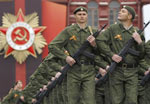Politics
How bin Laden emailed without being detected by US
Updated: 2011-05-13 07:56
(Agencies)
WASHINGTON - Despite having no Internet access in his hideout, Osama bin Laden was a prolific email writer who built a painstaking system that kept him one step ahead of the US government's best eavesdroppers.
His methods, described in new detail to The Associated Press by a counterterrorism official and a second person briefed on the US investigation, served him well for years and frustrated Western efforts to trace him through cyberspace. The arrangement allowed bin Laden to stay in touch worldwide without leaving any digital fingerprints behind.
| ||||
Bin Laden's system was built on discipline and trust. But it also left behind an extensive archive of email exchanges for the US to scour. The trove of electronic records pulled out of his compound after he was killed last week is revealing thousands of messages and potentially hundreds of email addresses, the AP has learned.
Holed up in his walled compound in northeast Pakistan with no phone or Internet capabilities, bin Laden would type a message on his computer without an Internet connection, then save it using a thumb-sized flash drive. He then passed the flash drive to a trusted courier, who would head for a distant Internet cafe.
At that location, the courier would plug the memory drive into a computer, copy bin Laden's message into an email and send it. Reversing the process, the courier would copy any incoming email to the flash drive and return to the compound, where bin Laden would read his messages offline.
It was a slow, toilsome process. And it was so meticulous that even veteran intelligence officials have marveled at bin Laden's ability to maintain it for so long. The US always suspected bin Laden was communicating through couriers but did not anticipate the breadth of his communications as revealed by the materials he left behind.
Navy SEALs hauled away roughly 100 flash memory drives after they killed bin Laden, and officials said they appear to archive the back-and-forth communication between bin Laden and his associates around the world.
Al-Qaida operatives are known to change email addresses, so it's unclear how many are still active since bin Laden's death. But the long list of electronic addresses and phone numbers in the emails is expected to touch off a flurry of national security letters and subpoenas to Internet service providers. The Justice Department is already coming off a year in which it significantly increased the number of national security letters, which allow the FBI to quickly demand information from companies and others without asking a judge to formally issue a subpoena.
Officials gave no indication that bin Laden was communicating with anyone inside the US, but terrorists have historically used US-based Internet providers or free Internet-based email services.
The cache of electronic documents is so enormous that the government has enlisted Arabic speakers from around the intelligence community to pore over it. Officials have said the records revealed no new terror plot but showed bin Laden remained involved in al-Qaida's operations long after the US had assumed he had passed control to his deputy, Ayman al-Zawahri.
The files seized from bin Laden's compound not only have the potential to help the US find other al-Qaida figures, they may also force terrorists to change their routines. That could make them more vulnerable to making mistakes and being discovered.
Specials

Sino-US Dialogue
China and the US hold the third round of the Strategic and Economic Dialogue from May 9-10 in Washington.

New wave
Coastal city banks on marine sector to ride next stage of economic development

V-Day parade
A military parade marking the 66th anniversary of the Soviet victory over Nazi.



